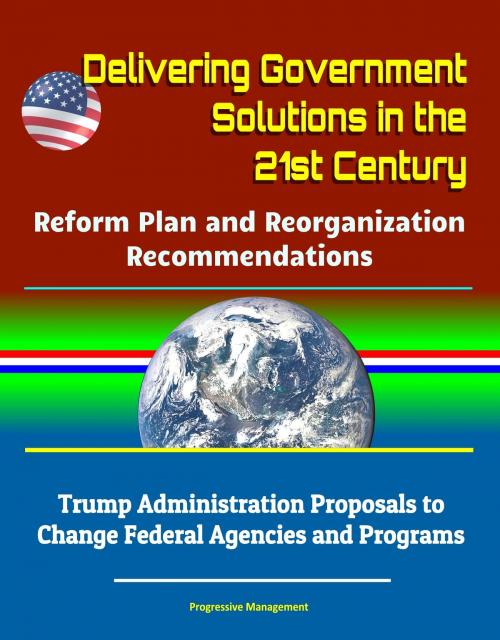Delivering Government Solutions in the 21st Century: Reform Plan and Reorganization Recommendations - Trump Administration Proposals to Change Federal Agencies and Programs
Nonfiction, Social & Cultural Studies, Political Science, Government| Author: | Progressive Management | ISBN: | 9780463331835 |
| Publisher: | Progressive Management | Publication: | June 24, 2018 |
| Imprint: | Smashwords Edition | Language: | English |
| Author: | Progressive Management |
| ISBN: | 9780463331835 |
| Publisher: | Progressive Management |
| Publication: | June 24, 2018 |
| Imprint: | Smashwords Edition |
| Language: | English |
This important June 2018 report has been professionally converted for accurate flowing-text e-book format reproduction.
This report outlines the Administration's analysis and recommendations for structural realignment of the Executive Branch to better serve the mission, service, and stewardship needs of the American people. While some of the recommendations identified in this volume can be achieved via Executive administrative action, more significant changes will require legislative action as well. By sharing key findings, the Administration offers this report as a cornerstone to build productive, bipartisan dialogue around realigning the Federal Government mission delivery model to make sense in the 21st Century. As such, while some of the proposals are ready for agency implementation, others establish a vision for the Executive Branch that will require further exploration and partnership with the Congress. Finally, reorganization is one tool among many that this Administration is using to drive transformational change in Government. Meeting the needs of the American people, as well as the President's mandate for greater efficiency, effectiveness, and accountability, requires a range of transformational approaches to support reorganization. To that end, the President's Management Agenda (PMA) outlines a range of additional priorities and tools that, in combination, will create an Executive Branch that is prepared to meet the needs of the American people both now and in the future. The Administration welcomes constructive dialogue and consideration of all the tools, capabilities, and organizational principles that help support our mission and better serve the public.
I. The Mandate for Reform * II. Organizational Reform Principles * III. Overview of Organizational Alignment Priorities * IV. Looking Ahead * V. Government-wide Reorganization Proposals * Appendix: Agency-Specific Reform Proposals * Department of Education and the Workforce * Consolidate Non-Commodity Nutrition Assistance Programs into HHS, Rename HHS the Department of Health and Public Welfare and Establish the Council on Public Assistance * Consolidate Mission Alignment of Army Corps of Engineers Civil Works with Those of Other Federal Agencies * Reorganize Primary Federal Food Safety Functions into a Single Agency, the Federal Food Safety Agency * Move Select USDA Housing Programs to HUD * Merge the National Marine Fisheries Service (NMFS) * with the U.S. Fish and Wildlife Service (FWS) * Consolidation of Environmental Cleanup Programs * Optimization of Humanitarian Assistance * Development Finance Institution * Structural Transformation of Central Washington-Based Bureaus at the U.S. Agency for International Development * Reorganizing the U.S. Office of Personnel Management * Consolidation of Federal Veterans Cemeteries * Reorganizing Economic Statistical Agencies * Consolidation of the Department of Energy's Applied Energy Offices and Mission Refocus. * Divesting Federal Transmission Assets * Restructure the Postal Service * DOT Mission Adjustments * Reform Federal Role in Mortgage Finance * Create the Bureau of Economic Growth * U.S. Public Health Service Commissioned Corps * Improving NASA's Agility through Increased Use of Federally Funded Research and Development Centers * Management Consolidation of Federal Graduate Research Fellowships * Rationalize the Federal Real Property Approach * Consolidate and Streamline Financial Literacy Efforts * Streamline Small Business Programs * Consolidation of Certain Protective Details * Small Grants Consolidation * Transition to Electronic Government * Customer Experience (CX) Improvement Capability * Next Generation Federal Student Aid Processing & Servicing Environment * Solving the Federal Cybersecurity Workforce Shortage * The GEAR Center * Transfer of Background Investigations from the Office of Personnel Management to the Department of Defense. * Strengthening Federal Evaluation * Bibliography
This important June 2018 report has been professionally converted for accurate flowing-text e-book format reproduction.
This report outlines the Administration's analysis and recommendations for structural realignment of the Executive Branch to better serve the mission, service, and stewardship needs of the American people. While some of the recommendations identified in this volume can be achieved via Executive administrative action, more significant changes will require legislative action as well. By sharing key findings, the Administration offers this report as a cornerstone to build productive, bipartisan dialogue around realigning the Federal Government mission delivery model to make sense in the 21st Century. As such, while some of the proposals are ready for agency implementation, others establish a vision for the Executive Branch that will require further exploration and partnership with the Congress. Finally, reorganization is one tool among many that this Administration is using to drive transformational change in Government. Meeting the needs of the American people, as well as the President's mandate for greater efficiency, effectiveness, and accountability, requires a range of transformational approaches to support reorganization. To that end, the President's Management Agenda (PMA) outlines a range of additional priorities and tools that, in combination, will create an Executive Branch that is prepared to meet the needs of the American people both now and in the future. The Administration welcomes constructive dialogue and consideration of all the tools, capabilities, and organizational principles that help support our mission and better serve the public.
I. The Mandate for Reform * II. Organizational Reform Principles * III. Overview of Organizational Alignment Priorities * IV. Looking Ahead * V. Government-wide Reorganization Proposals * Appendix: Agency-Specific Reform Proposals * Department of Education and the Workforce * Consolidate Non-Commodity Nutrition Assistance Programs into HHS, Rename HHS the Department of Health and Public Welfare and Establish the Council on Public Assistance * Consolidate Mission Alignment of Army Corps of Engineers Civil Works with Those of Other Federal Agencies * Reorganize Primary Federal Food Safety Functions into a Single Agency, the Federal Food Safety Agency * Move Select USDA Housing Programs to HUD * Merge the National Marine Fisheries Service (NMFS) * with the U.S. Fish and Wildlife Service (FWS) * Consolidation of Environmental Cleanup Programs * Optimization of Humanitarian Assistance * Development Finance Institution * Structural Transformation of Central Washington-Based Bureaus at the U.S. Agency for International Development * Reorganizing the U.S. Office of Personnel Management * Consolidation of Federal Veterans Cemeteries * Reorganizing Economic Statistical Agencies * Consolidation of the Department of Energy's Applied Energy Offices and Mission Refocus. * Divesting Federal Transmission Assets * Restructure the Postal Service * DOT Mission Adjustments * Reform Federal Role in Mortgage Finance * Create the Bureau of Economic Growth * U.S. Public Health Service Commissioned Corps * Improving NASA's Agility through Increased Use of Federally Funded Research and Development Centers * Management Consolidation of Federal Graduate Research Fellowships * Rationalize the Federal Real Property Approach * Consolidate and Streamline Financial Literacy Efforts * Streamline Small Business Programs * Consolidation of Certain Protective Details * Small Grants Consolidation * Transition to Electronic Government * Customer Experience (CX) Improvement Capability * Next Generation Federal Student Aid Processing & Servicing Environment * Solving the Federal Cybersecurity Workforce Shortage * The GEAR Center * Transfer of Background Investigations from the Office of Personnel Management to the Department of Defense. * Strengthening Federal Evaluation * Bibliography















